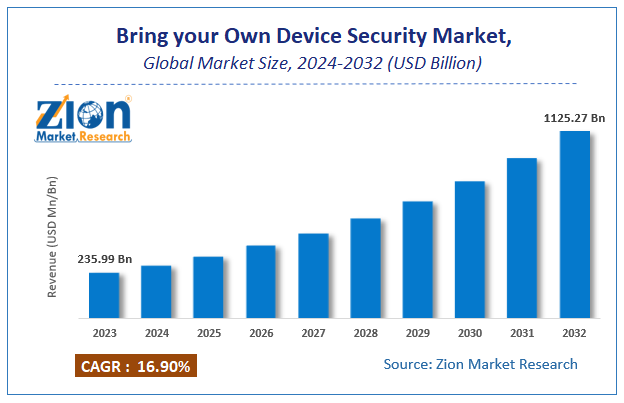Bring your Own Device Security Market Size, Share, Trends, Industry Analysis & Growth(2024–2032)

The global bring your own device security market was estimated to be worth USD 235.99 billion in 2024 and is expected to grow to USD 1125.27 billion by the end of 2032, according to a report released by Zion Market Research. Over the course of the projection period, the market is anticipated to expand at a CAGR of 16.9%. The study examines the factors that will propel growth, provide challenges, and affect demand in the global Bring Your Own Device Security Market over the course of the projected year. It will also support you in navigating and investigating the opportunities that are emerging in the Bring Your Own Device Security sector.
✈👉Get a Free Sample: 🚀https://www.zionmarketresearch.com/sample/bring-your-own-device-security-market
Introduction
The Bring Your Own Device (BYOD) trend has transformed the workplace, allowing employees to use their personal devices — such as smartphones, tablets, and laptops — for work-related tasks. While this shift offers numerous benefits, including increased flexibility and productivity, it also presents significant security challenges. The BYOD Security market is evolving rapidly to address these challenges, with businesses investing in advanced solutions to protect sensitive data and ensure compliance. This article explores the current state of the BYOD security market, key drivers, challenges, and future trends.
Overview of the Global Bring Your Own Device Security Market
It is anticipated that the global market for bring-your-own-device security would fundamentally alter how people view corporate work. Security solutions for “bring your own device” (BYOD) allow remote control of laptops or mobile devices used for work. The market is growing faster as a result of employee productivity increases, which are ultimately advantageous for businesses. The new Bring Your Own Device (BYOD) policy eliminates any geographical restrictions and allows you to work from anywhere with the ease of connectivity and secure mobile identity management.
The market for BYOD security has been continuously developing due to the rising popularity of BYOD policies and the growing sophistication of cybersecurity threats. The market was estimated to be worth $XX billion in 2024. According to forecasts, it is expected to increase at a compound annual growth rate (CAGR) of X% to reach $XX billion by 2028. The requirement for strong security solutions that can protect data across a wide range of personal devices used in business contexts is driving the market’s growth.

Worldwide The market for bring your own device security: growth factors
Bring-your-own-device (BYOD) policies are being promoted by companies all over the world, enabling staff members to use their mobile devices for work-related activities during their free time. The BYOD concept enables employees to access data instantly, enabling them to make quick decisions. This drives the bring-your-own-device security market worldwide by requiring the deployment of efficient BYOD security solutions to stop unauthorized access to the company’s data. Another significant factor propelling the BYOD security industry’s expansion is the growing demand for cell phones.
Workers want to be able to view and send emails, among other work-related tasks, while they are on the road. This guarantees that workers are productive wherever they are. As the possibility of security risks increases, so does the necessity for effective BYOD security solutions. There are other sources of BYOD risk besides malevolent hackers. Even the most innocuous software packages that use network access within the organization can pose a risk to data and security.
These applications can read SMS messages, access contact lists, install software on the phone, and provide user data to advertising. In order to stop criminal activity, the BYOD security sector is going through a paradigm shift from MDM to app-centric MAM. In addition to all of these, security issues, data theft, and hostile attacks could hinder the expansion of the worldwide market for bring-your-own-device security.
Covid-19 essentially affected every industry in terms of losses, production delays or uncertainty, transportation issues, and numerous other issues. Amid concerns over COVID-19, BYOD security was said to be a crucial requirement. Owing to the lockdown, businesses implemented the work from home model, which is now the standard operating procedure. This was the only way for employees to continue working during the epidemic. Businesses are finding that BYOD rules save costs, and studies show that workers are more productive while working from home. The BYOD policy makes it simple to store data and keep records, and it also makes hardware updates simple.

Worldwide Segmenting the Bring Your Own Device Security Market
The bring your own device security market is divided into segments based on end user, geography, security software, devices type, and solutions.
The market is divided into laptops, tablets, and smartphones based on the type of device.
Mobile device management, mobile application management, mobile content management, and mobile identity management make up the solution segment.
The market is segmented into three categories based on security software: network security, mobile data security, and mobile device security.
The market is segmented into three end-user segments: government agencies, small and medium-sized businesses, and major corporations.
✈👉Directly Purchase a copy of the report with TOC: 🚀https://www.zionmarketresearch.com/toc/bring-your-own-device-security-market
Market Analysis of Bring Your Own Device Security: Report Scope

Regional Analysis of the Global Bring Your Own Device Security Market
During the projected period, North America is anticipated to hold the top spot in the worldwide bring your own device security market. The demand is rising due to the widespread acceptance of BYOD among internet users and the expansion of workplace mobility. In addition, given the abundance of businesses in the area and the requirement for security-based technology improvements, the market must be more competitive and productive in order for businesses to expand their market presence.
Due to significant foreign investments and collaborations in places like China, Singapore, India, and others, Asia Pacific is also expanding rapidly and is predicted to do so in the near future. The bring your own device market is expanding due to the younger generation’s increased use and purchase of smartphones in the area. In terms of market enhancement and valuation, European nations are on par with these places. There, too, growth and demand are predicted.
Market Drivers
- Increased Adoption of BYOD Policies: Many organizations have embraced BYOD policies to enhance employee satisfaction and productivity. As more businesses implement these policies, the demand for effective BYOD security solutions has risen, prompting investments in technologies that can manage and secure personal devices.
- Rising Cybersecurity Threats: The increasing frequency and sophistication of cyberattacks, including malware, ransomware, and phishing, have heightened the need for advanced security measures. BYOD environments are particularly vulnerable to these threats, driving the demand for solutions that can protect against data breaches and unauthorized access.
- Regulatory Compliance: Stricter data protection regulations, such as the General Data Protection Regulation (GDPR) and the California Consumer Privacy Act (CCPA), have made it imperative for organizations to secure personal and sensitive information. Compliance requirements are pushing businesses to adopt comprehensive BYOD security solutions to avoid legal penalties and protect customer data.
- Technological Advancements: Innovations in cybersecurity technology, including endpoint detection and response (EDR), mobile device management (MDM), and unified endpoint management (UEM), are enhancing the effectiveness of BYOD security solutions. These technologies enable organizations to monitor, manage, and secure personal devices more efficiently.
Key Players
Several companies are leading the BYOD security market, offering a range of solutions to address various security needs:
- Symantec Corporation (now part of Broadcom): Known for its comprehensive cybersecurity solutions, Symantec offers robust BYOD security products, including endpoint protection and data loss prevention (DLP) solutions.
- McAfee Corp.: McAfee provides a suite of security solutions for BYOD environments, including mobile security, threat intelligence, and advanced threat protection.
- IBM Security: IBM offers a range of security solutions for managing and protecting BYOD environments, including endpoint security, identity and access management (IAM), and security information and event management (SIEM).
- VMware, Inc.: VMware’s Workspace ONE platform provides unified endpoint management and mobile security solutions, enabling organizations to secure and manage personal devices effectively.
- Cisco Systems, Inc.: Cisco offers advanced security solutions for BYOD environments, including network security, threat detection, and secure access technologies.
These companies are continuously innovating to address the evolving security challenges associated with BYOD policies.
Applications
- Enterprise Security: BYOD security solutions are primarily used in enterprise environments to manage and secure personal devices used for work purposes. These solutions help organizations enforce security policies, monitor device activity, and protect sensitive data.
- Healthcare: In the healthcare sector, BYOD security solutions are crucial for protecting patient data and ensuring compliance with regulations such as HIPAA. Mobile devices are often used by healthcare professionals to access patient information and medical records, making security a top priority.
- Finance: Financial institutions utilize BYOD security solutions to safeguard sensitive financial data and protect against cyber threats. Personal devices used by employees for accessing financial systems and conducting transactions need to be secured to prevent data breaches and fraud.
- Education: Educational institutions are increasingly adopting BYOD policies to facilitate learning and collaboration. BYOD security solutions help protect student and faculty data, secure educational resources, and manage access to institutional systems.
Challenges
The BYOD security market faces several challenges:
- Data Privacy Concerns: Balancing security with user privacy is a significant challenge in BYOD environments. Organizations must implement security measures that protect corporate data without infringing on employees’ personal privacy.
- Device Diversity: The wide variety of personal devices and operating systems used in BYOD environments complicates the implementation of uniform security measures. Ensuring compatibility and effectiveness across different devices can be challenging.
- Employee Resistance: Employees may resist security measures that impact their personal device usage or privacy. Educating users and fostering a culture of security awareness are essential to overcoming this resistance.
- Integration with Existing Systems: Integrating BYOD security solutions with existing IT infrastructure and security systems can be complex. Organizations must ensure that new solutions work seamlessly with their current technology stack.
Future Trends
Several trends are shaping the future of the BYOD security market:
- Zero Trust Security Model: The Zero Trust model, which assumes that no user or device is trusted by default, is gaining traction in BYOD security. This approach involves continuous verification and monitoring of user and device activity, enhancing overall security.
- AI and Machine Learning: Artificial intelligence (AI) and machine learning are being increasingly integrated into BYOD security solutions to improve threat detection, automate responses, and enhance security analytics.
- Enhanced Mobile Device Management (MDM): Advances in MDM solutions are providing more granular control over personal devices, enabling organizations to enforce security policies, manage applications, and protect data more effectively.
- Cloud-Based Security Solutions: Cloud-based BYOD security solutions are becoming more popular due to their scalability, flexibility, and cost-effectiveness. These solutions offer centralized management and protection for a diverse range of devices and applications.
Conclusion
The Bring Your Own Device (BYOD) security market is rapidly evolving to address the challenges and opportunities associated with the use of personal devices in corporate environments. As the adoption of BYOD policies continues to grow, organizations are investing in advanced security solutions to protect sensitive data, ensure compliance, and manage cybersecurity risks. With emerging trends such as the Zero Trust model and AI-driven security, the BYOD security market is poised for continued innovation and growth, providing businesses with the tools they need to secure their mobile workforce effectively.
✈👉Enquiry for buying: 🚀https://www.zionmarketresearch.com/inquiry/bring-your-own-device-security-market
📞Contact Us:
Zion Market Research212
USA/Canada Toll Free: 1 (855) 465–4651
Newark: 1 (302) 444–016611\s
📲Web: https://www.zionmarketresearch.com/
👉Blog: https://zmrblog.com/
🌎👇Browse other trend reports:
https://www.linkedin.com/pulse/broad-ion-beam-technology-market-size-share-trends-0njfe
https://www.linkedin.com/pulse/tunnel-lighting-market-size-share-report-forecast2024-2032-ovjle
https://www.linkedin.com/pulse/ultra-mobile-devices-umd-market-size-share-trends-yslce
https://www.linkedin.com/pulse/smart-ticketing-market-size-share-trends-industry-yrspe
https://www.linkedin.com/pulse/bring-your-own-device-security-market-size-share-lqpge
%20Market%20main%20jpg.png)
Comments
Post a Comment